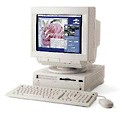This column was first published in the MUGOO Newsletter
in October 2000.
Don't touch that mouse! Let's jump in. Several movies (well, snips
from movies) can be found at http://home.att.net/~myperforma.
 In order to view or hear the movies, either Movie
Player 2.5.1, SimpleText 1.4, or QuickTime 2.5 software must be
installed as a minimum!
In order to view or hear the movies, either Movie
Player 2.5.1, SimpleText 1.4, or QuickTime 2.5 software must be
installed as a minimum!
There are several choices for creating movie files on my Performa.
My choices are limited by the type of digitizing hardware used to
convert data received from a device which is the source that generates
or stores the audio/video data. The two parts must be compatible in
order to create a readable file.
The table below matches digitizing hardware with the data source,
whose output can be saved as a file that can be played by an
appropriate application such as QuickTime.
|
|
Digitizing Hardware or Medium
|
|
|
Serial Port
|
Microphone Jack
|
TV Tuner
|
Video Card
|
CD-ROM
|
MPEG Card
|
|
Recording or Storage Device
|
QuickCam
|
X
|
|
|
|
|
|
|
Video Camera
|
|
|
X
|
X
|
|
|
|
TV
|
|
|
X
|
X
|
|
|
|
Microphone
|
|
X
|
|
|
|
|
|
CD-ROM
|
|
|
X
|
X
|
X
|
X
|
|
VCR/VHS Tape
|
|
|
X
|
X
|
|
|
The Connectix QuickCam is connected by a serial cable to the
motherboard via the serial port. An Apple TV/Tuner Card is not
required. The output is audio/video recorded as a "Quick Movie" file.
Note that my QuickCam records in black and white as well as shades of
gray.
Several different ways to record or retrieve video and/or sound are
possible using the Apple TV/Tuner Card. Movies are recorded in millions
of color by using a VHS video camera. I use a Panasonic PV-320D (circa
1987) video camera to either record video or as a VCR on the fly to
play back previously recorded movies. I then hook the camera to the
video card input ports using cables with RCA jacks. The output is a
SimpleText movie file.
By hooking up a TV antenna, hooked into the TV card, which in turn,
is installed directly onto the motherboard, my Performa can be used as
a VCR to record a TV show, let's say M*A*S*H. The output again is a
SimpleText movie file, albeit quite large. The same is true of audio
files generated from using a plain talk microphone or CD-ROM the device
to generate data that is then digitized. The files saved are large
files.
Reading and playing back files is a matter of hardware and software.
And fun to use!
Next Time: Software and editing
movies.

 In order to view or hear the movies, either Movie
Player 2.5.1, SimpleText 1.4, or QuickTime 2.5 software must be
installed as a minimum!
In order to view or hear the movies, either Movie
Player 2.5.1, SimpleText 1.4, or QuickTime 2.5 software must be
installed as a minimum!
